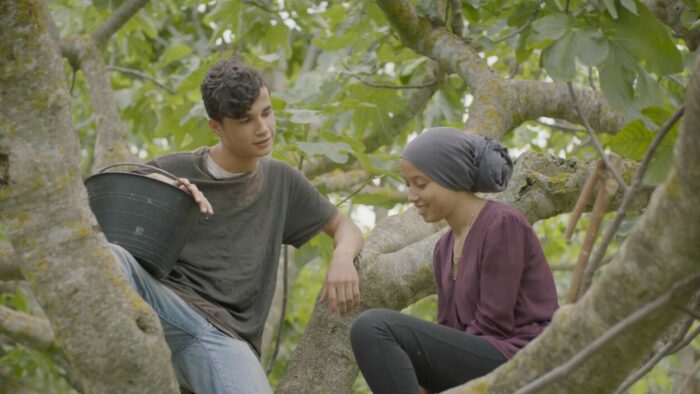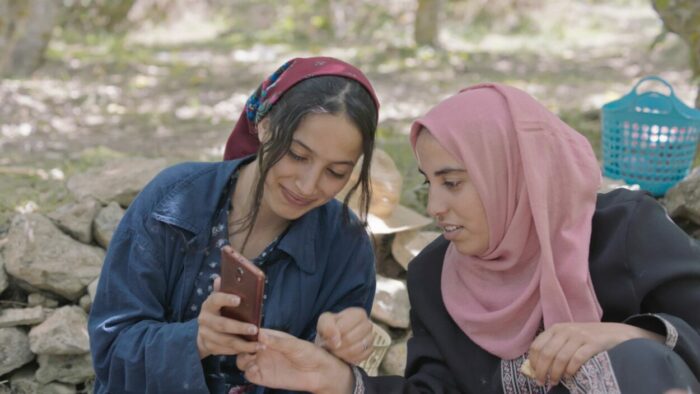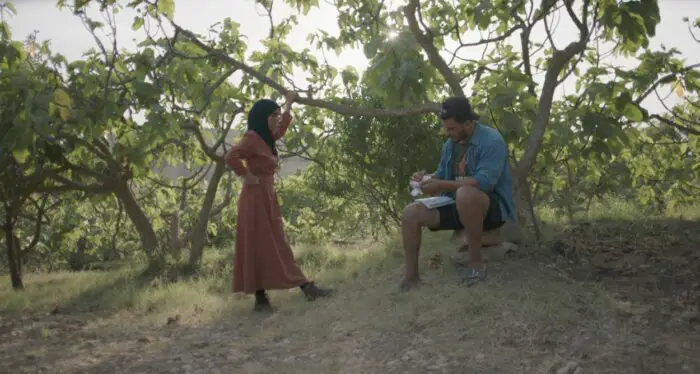Under the Fig Trees, Tunisia’s 2023 Official Academy Award nomination, is as delicate and enticing as freshly-picked ripe fruit, a film set on a single hot summer day in a picturesque orchard where a crew of workers navigates work, love, and life under the ever watchful gaze of their foreman. The film’s premise is elegantly simple, just a day in the life of orchard workers, and there is no traditional narrative other than the passage of the workday; freed from genre conventions and narrative expectations, the film presents a sunny, smart harvest of pithy observations and gentle moments.
The workers arrive at dawn, piling into the bed of a small pickup truck that conveys them to the orchard. Even in the ritual of boarding, there are conflicts and challenges: who gets to sit in the cab, who can board first, what one can do—or not—on the way. The orchard itself makes for a fascinating setting. It is strictly bound, its parameters defined, but also porous: the workers can, discreetly, steal away a few precious moments, or even a few poached figs, but they are under watch and must keep to its prescribed boundaries. The blazing sun dapples, but the trees themselves provide a thick cover, their branches often restricting characters’ point-of-view or creating small pockets for private conversations. The orchard provides relief, but it also oppresses.

The fruit is tender and requires a delicate touch. The fig is soft and sensual, prone to damage. One cannot pick the fruit if not yet ripe, and the trees’ branches are themselves fragile. Picked fruit must be carefully transported in heavy buckets—filled to an exact level—then carefully arranged, without bruising or breaking, in crates to be taken to market. Drop a bucket, break a branch, work too slowly, pick too early, gossip too much—any of these will earn a scolding, or perhaps even firing, from the foreman, who keeps a close watch on the goings-on.
The workers are comprised of men and women, young and old, experienced and new, allowing for gender and intergenerational dynamics to unfold. The young hope, plan, flirt, and taunt, their energy boundless; the old debate and reminisce, their bodies broken down by years of toil. A group of young girls takes center stage for most of the narrative: it is they on whom the film takes its primary focus, these girls who might for decades toil under the fig trees or who might find a way to leave the orchard for a different, perhaps better, life.

The young female workers own phones and are aware of social media, but for the most part their lives consist of work and school. During the workday, the phones are put away, lest the foreman spy them loafing. All of them are friends, but there are small seeds of division. Some wear the hijab at every moment, another only a headscarf. They argue about the boys, one of them recently returned to the area, another the local hottie, and about each other, monitoring each other’s behavior for any excessive flirtatiousness or scandal.
As the day progresses, conflicts escalate. One of the girls is taken aside by the foreman with a malicious intent. One of the boys is accused of having pilfered a crate of figs for himself. A worker faints from overexertion. Evidence of dropped buckets and broken branches must be covered. The girls’ arguments nearly escalate to the point of physical conflict. And on payday, nearly every worker has cause for concern about their compensation.
None of these events becomes itself the center of the Under the Fig Tree‘s narrative, as the film eschews a linear plot for a less causal, more casual slice-of-life approach. Yet it never meanders, and each event has its purpose: the foreman’s attempted assault, for instance, a stark reminder of the harassment women face in the workplace, or his constant surveillance symbolizing eternal conflict between labor and management. At the end of the film’s ninety minutes, it’s not that nothing has happened, as Cesar Zavattini famously opined of neorealism—in fact, plenty does—but little has changed. Tomorrow will be another day, not unlike yesterday and not unlike today.
Director and co-writer (with Ghalya Lacroix and Peggy Hamann) Erige Sehiri, documentary trained and making her first feature film, cast non-professional actors and worked without a written script, instead providing general directions about characters and relationships. As a result, the actors’ portrayals are all understated and convincing, perfectly naturalistic and plausible. (A note for those of you like myself watching with no knowledge of Arabic: the subtitles in English do not always make perfectly clear which character is speaking which line, making for some occasional difficulty.) Sehiri was casting for a planned feature when she met Fide (Fdhili, who plays Fidé), a local Tunisian girl who took her to the fields where she worked; the more they talked, the more Sehiri became convinced the orchard, and the girls’ work in it, should instead make for the content of her film. There, in the orchard, were the themes of virtue, oppression, surveillance, and opportunity all along.

With DP Frida Marzouk, Sehiri’s orchard works perfectly as a setting both in figurative, thematic terms as well as practical and logistic ones. The fig trees’ leafy branches and dense cover provide small alcoves for close shots and intimate dialogues away from the crew foreman’s constant attempts at surveillance; much as he tries, he can’t see everything, everywhere. Nearly every shot is in medium and close-up until the waning minutes of the film, when wide shots begin to depict the final stages of the day’s harvest and the workers’ return to town.
To make a full and engrossing film on location, in the thick of a fig orchard, in oppressive summer heat, with a non-professional cast of actors and no traditional script to speak of, is in itself a significant accomplishment. But when you watch Under the Fig Trees, Sehiri’s film is so enchanting you won’t be thinking of its making: you’ll be thinking instead of these young women’s aspirations, foibles, jealousies, and obstacles, hoping and rooting for them to find a life someday beyond the orchard in which they toil, this day and every day.
Under the Fig Trees is available to stream on Apple TV+ and Prime Video.




